Karen Roy, MSW, LCSW, provides feedback while repair technician Ted Fanguy adjusts the knee blocks on a robotic mobility device. The device is adjustable for people ranging from 4’7” (140 cm) to 6’3” (190 cm).
Introduction
Personal narratives of people who use standing devices are necessary to review, as they can provide intricate details about the benefits of standing that can inform and strengthen future studies on standing devices. This article aims to align the current evidence with end-user insights about standing as a therapeutic activity. Those insights are informed by the article’s co-author, Karen Roy, MSW, LCSW, a T10 complete paraplegic who has used standing equipment as part of her routine for nearly 32 years.
Along with co-author Cara Masselink, OTR/L, ATP, MS, PhD, this author team examines the clinical health benefits of standing and reviews vital aspects of standing equipment that make a standing program successful. What may make this article unique for many clinicians, however, is the voice of a standing system user who reveals the gaps in therapists’ understanding of what standing patients need, and suggestions about how to close those gaps.
Physical Benefits
Karen Roy was a sophomore at Louisiana State University in 1987 when she was shot in the back in an armed robbery. The bullet caused a T10 complete spinal cord injury and while Roy was learning to use a manual wheelchair for mobility, she also discovered several types of standing devices. Roy used reciprocating gate orthotic braces (RGOs), standing frames and a standing power wheelchair in rehab and then in her home upon discharge. The therapists taught her the physical benefits of standing, including decreasing the risk of contractures, fractures and wounds. Her therapists at Methodist Rehabilitation Hospital in Jackson, Miss, also told her that standing frequently could help decrease bone loss and prevent fractures. Roy acted on this advice and followed a routine of standing for 2 hours a day, 3 days a week.
She continued to stand with various devices for the next 32 years, all while finishing college and receiving a master’s degree in social work, getting married, and having three children and working. Roy is now 52 years old and has never had a wound, fracture or contracture in the last 32 years. There are not many people who have lived with a spinal cord injury for more than 30 years who can say they have never experienced secondary complications. She credits her excellent health to her persistence in taking time to stand as much as possible.
Functional Benefits
Most homes are designed using available vertical space. However, reaching necessary items in upper cabinets, the refrigerator or microwave is often impossible for a wheelchair user. Furthermore, looking at items on the wall that are positioned at standing height, over time, can grow fatiguing. Standing is the default position the ambulatory population maintains when cooking; the ability to stand and cook is a safer option for many people. Cooking while sitting with one’s face close to the stove is not ideal. Standing allows a person with a mobility impairment to reach necessary items in upper cabinets independently. The ability to reach objects, cook and clean when using a mobile standing device provides a person with a disability freedom they do not have while in a seated position. For many people who are affected by disabilities the option to stand increases their independence with daily tasks; this may reduce the number of caregiver hours needed.
There is a severe shortage of caregivers in the United States. For Roy, the ability to stand meant that when theybuilt a house, not everything needed to be at seated level. While she found that retrieving dishes was better at a seated level, standing while setting the table and cooking were more efficient. The house Roy built with her husband has a kitchen designed with both average counter heights (36 inches) and one shorter counter height (32 inches). The taller counter tops accommodated Roy’s 6-foot-1-inch-tall, able-bodied husband and Roy when she is standing. The shorter counter is used when Roy is seated for food preparation and eating. Without her mobile standing device, she would be unable to retrieve items placed near the back of the taller counter.
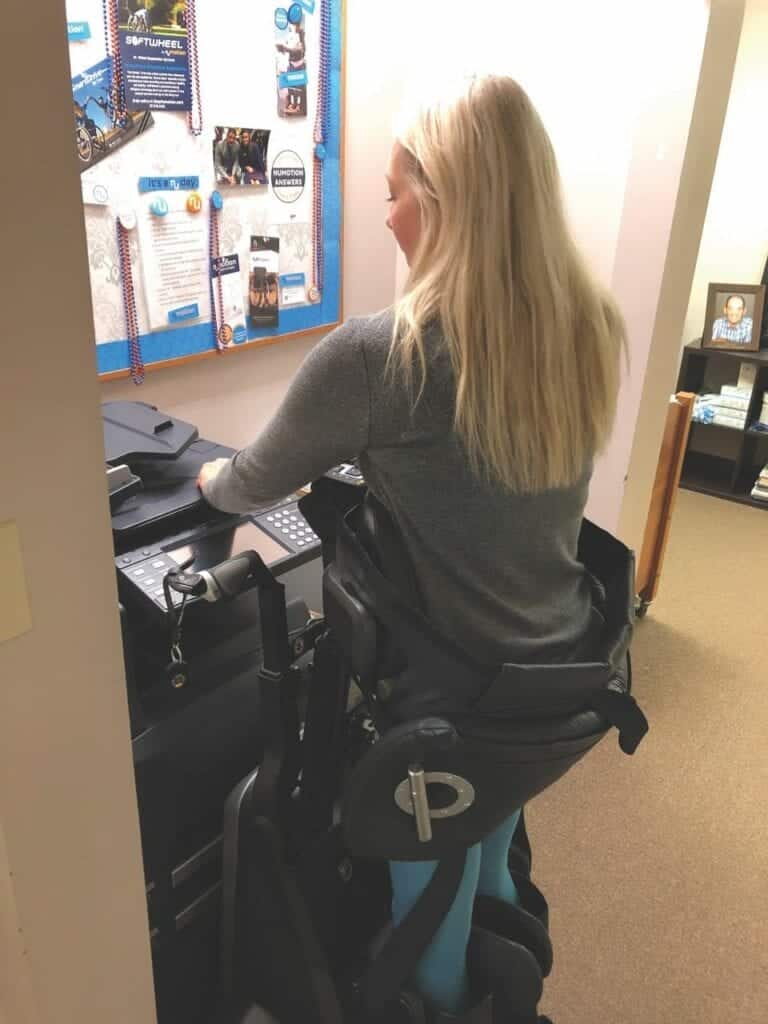
Psychological Benefits
Amy Cuddy is a social psychologist whose research revealed that body language changes the way others think about us and the way we think about ourselves. Cuddy’s research specifically looked at the fact that people who take up large amounts of space by standing, putting their legs out and arms in an open position, are seen as powerful. People who cross their legs, hunch over, and hold their arms in small positions are seen as weak and submissive. Wheelchair users often do not have a choice, and Cuddy’s research suggests that the person in the seated position will be perceived as less powerful and is more likely to internalize feelings of inferiority.
[ RELATED: (White Paper) 12 Important Benefits of Standing, by Jill Marlow, OTD/S ]
There is a reason the phrase, “Looking down on someone,” is negative. It implies the person standing above is more powerful than the person in the “down” position. Roy worked in a rehabilitation hospital for years always sitting in her wheelchair. One day she demonstrated a walking robotic device at the hospital and immediately recognized that the dynamics between her and the hospital staff changed significantly when she could look them in the eye. Roy reported feeling empowered while standing and talking to therapists and physicians. In the same way, Roy found that a standing position changed the dynamics when parenting her three children. After receiving a mobile standing device, she found that she was perceived as more powerful in a standing position, especially when reprimanding a 6-foot-2-inch-tall teenage boy.
Roy often felt physically and psychologically exhausted after being looked down on from above by people all day, but when standing felt more confident looking others in the eye during conversations. Roy describes the first time she stood in a standing robotic device and could move around the CRT conference and talk to able-bodied people eye-to-eye as “euphoric.” Roy is 5 feet 7 inches tall, and the standing robotic device adds 4 inches to her height. Powerful, happy, respected, and radiant were just a few of the words she used to describe her feelings while conversing in a standing position.
Consistent with Cuddy’s research, standing has been associated with reported improvements in quality of life and feelings of health and well-being.1,2,3 In addition to the impact of the standing position on social interaction, Roy appreciated other benefits such as being able to give a hug to a friend or a kiss to a loved one while standing. Additional research focused on the specific association between standing, social interaction, and mental health benefits would strengthen the current evidence base.
Literature Support
There are studies that support many benefits reported by people who use devices for standing programs.4,5 More rigorous studies would be beneficial, but there are ethical obstacles to conducting studies that withhold a standard of care, such as standing, from a group of people that would benefit from it.4 Also, people who use standing technology have a wide variety of diagnoses and stand in various ways, making it difficult to compare outcomes when there are so many variables.
There are numerous studies that have investigated the benefits of standing for able-bodied people. Chastin et al found a relationship between time spent in sitting and reclining postures and decreased the overall bone mineral density in the femur of women in their study.6 Additionally, standing and light ambulatory activity has been associated with improved glucose, lipid, and blood pressure regulation.7,8
More research needs to be done on the long-term benefits of standing, especially for wheelchair users. Additionally, the breadth of standing technology is quite vast, including mobile and immobile options; studies examining the impact of each system in a wheelchair user’s daily activities and health status are necessary to understand the unique circumstances when one may be useful over another.
[ PODCAST: Expert Tips for Standing Success, featuring Ginny Paleg, PT, DScPT, MPT ]
Life Without a Standing System
Access to standing devices is restricted, as many medical funding sources (such as Medicare) do not cover them. Many times standing is overlooked as an option due to competing priorities in the wheelchair users’ daily life. However, people with mobility impairments who sit in the same position all day often suffer from chronic pressure injuries, contractures, fractures, digestive issues, kidney stones and low back pain.
The comorbidities secondary to any diagnosis that prevents a person from being able to stand independently are debilitating and costly. Botox injections for contractures are expensive and the effects are temporary. Wound care is expensive and can result in the need for surgery and many months of incapacitation for the patient. Private insurance, Medicare and Medicaid spend millions of dollars a year on treating the secondary conditions of people with neurological disorders. Not to mention the lost tax revenue when people with disabilities are unable to work due to debilitating wounds and other comorbidities. Pressure injuries are difficult to heal and require a person to completely take pressure off of the wound in order in increase blood flow and promote healing.
The most common areas for pressure injury for wheelchair users is over the ischial tuberosities or the coccyx region. Taking pressure off of those areas requires a wheelchair user to be bedbound. The process of healing a pressure injury means a person is unable to work, take care of family or household duties for long periods of time. Pressure injuries cause a person to be completely homebound or hospitalized for months, which can also cause severe depression.
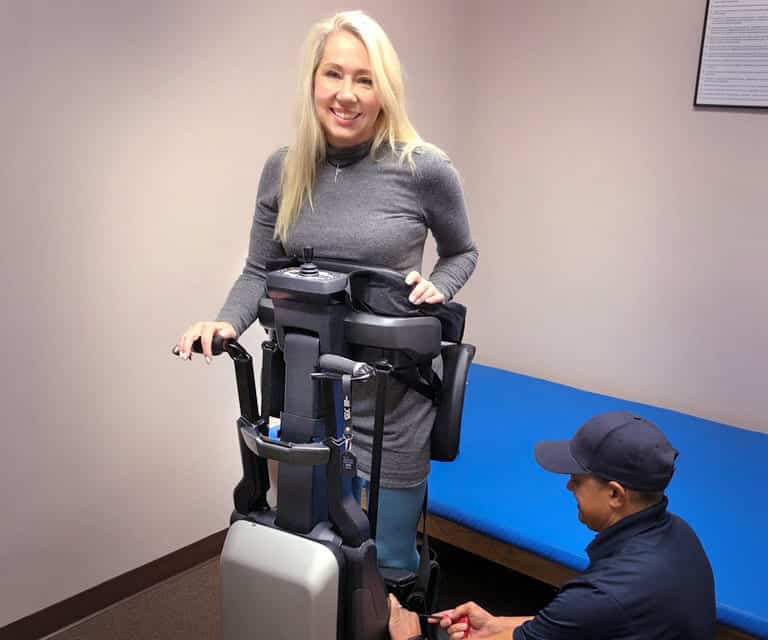
“It is our job as clinicians to educate lawmakers about the health benefits of standing and why paying for standing is cheaper than paying for the health problems that can occur when people do not stand.” — Karen Roy, LCSW
Effective Standing Programs
The key to success in a standing program is the same key to success in anything else: people must understand the purpose. Once people understand the purpose they begin a habit of standing regularly, and that habit can last a lifetime. For some people the purpose is to improve their overall health, but for others the goals might be more specific. For example, if a person is standing to decrease spasticity, the results are shorter-lived and therefore standing will need to be prescribed daily. Paleg et al performed a systemic review of evidence-based clinical practice on standing dosages in pediatric patients.9 It was determined that standing a minimum of three times per week for at least 2 hours per standing session is best for optimal results. While this was mainly done in the pediatric population, the dosage recommendation has easily been carried over into adults.
Any standing device that also allows a person to be mobile at the same time is ideal. Power wheelchair users often need assistance to transfer into a standing frame. If the transfer is difficult and energy consuming, it is likely the device will not be utilized frequently. Standing systems that are built into the power wheelchairs are more functional, easy to use, and therefore will be utilized more frequently according to many end-users who had previously utilized stationary standing frames.
The same concept applies to manual wheelchair users when it comes to finding a stander that allows the user to be mobile. The transfer to a stationary standing frame can be very difficult and often requires assistance. Study respondents report the transfer into a stationary standing frame is a barrier to standing and has led to abandonment of standing devices.1,2 Furthermore, few activities of daily living can be accomplished while standing in a static standing frame. Mobile standing devices on the market allow a manual wheelchair user to cook and access upper cabinets while in a standing position. Users of standing technology also report that the ability to move around while standing also increases the amount of time spent standing.
Conclusion
Standing technology is not new, but due to funding limitations with many funding sources and lack of provider knowledge, access to mobile standers has been extremely limited. Standing technology has changed drastically over the last several years, with manufacturers recognizing the need for more user-friendly technology and more customizable programming abilities. As the need for standing has grown, manufacturers have upped their game with standing technology.
With medical involvement, clinicians need to educate themselves on the technology, their patients in the standing process, and payors in order to obtain benefits of standing for their individual patients. Standing sequences should be personalized to each individual to ensure that not only is their standing accessible and functional, but also safe. It is important that medical personal are involved in all aspects of the standing power wheelchair process to ensure that standing limitations are taken into consideration.
Roy’s positive experiences with standing are mirrored by wheelchair users who regularly engage in standing programs. Improving access to standing technology for people with mobility impairment can be accomplished if patients, clinicians and payors continue to do their part in educating and advocating. Many studies have been written about the health benefits of standing for able-bodied people. Those documented health benefits all apply to persons with disabilities. People with disabilities have been denied the right to stand for far too long, and it’s time for that to change. RM
Cara Masselink, OTR/L, ATP, MS, PhD, is Team Leader of the OrthoSEAT, Assistive Technology and Augmentative Communication department at Mary Free Bed Rehabilitation Hospital in Grand Rapids, Mich. She is also an assistant professor at Western Michigan University in the Occupational Therapy Department.
Karen Roy, MSW, LCSW, received a master’s degree in social work from Louisiana State University. For the past 5 years she has worked at Numotion and is the Numotion Brand Ambassador. Roy was Ms. Wheelchair Louisiana 2018 and Ms. Wheelchair America 2019. The Ms. Wheelchair America organization’s competition is completely based on the woman’s history of advocacy and the ability to articulate her platform. Roy’s platform was “Stand for Life.” For more information, contact [email protected].
References
- Dunn RB, Walter JS, Lucero Y, et al. Follow-up assessment of standing mobility device users. Assist Technol. 1998;10(2):84-93. doi: 10.1080/10400435.1998.10131966
- Eng JJ, Levins SM, Townson AF, Mah-Jones D, Bremner J, Huston G. Use of prolonged standing for individuals with spinal cord injuries. Phys Ther. 2001;81(8):1392-1399.
- Walter SJ, Sola GP, Sacks J, Lucero Y, Langbein E, Weaver F. Indications for a home standing program for individuals with spinal cord injury. J Spinal Cord Med. 1999;18(1):152-158. doi: 10.1080/10790268.1999.11719564
- Newman M, Barker K. The effect of supported standing in adults with upper motor neurone disorders: a systematic review. Clin Rehabil. 2012;26(12):1059-1077. doi: 10.1177/0269215512443373
- Paleg G, Livingstone R. Systematic review and clinical recommendations for dosage of supported home-based standing programs for adults with stroke, spinal cord injury and other neurological conditions. BMC Musculoskelet Disord. 2015;16(358):1-16. doi: 10.1186/s12891-015-0813-x
- Chastin SFM, Mandrichenko O, Helbostadt JL, Skelton DA. Associations between objectively-measured sedentary behaviour and physical activity with bone mineral density in adults and older adults, the NHANES study. Bone. 2014; 64:254-262.
- Duvivier BMFM, Schaper NC, Koster A, et al. Benefits of substituting sitting with standing and walking in free-living conditions for cardiometabolic risk markers, cognition and mood in overweight adults. Frontiers in Physiology. 2017;8(353):1-9. doi: 10.3389/fphys.2017.00353
- Healy GN, Winkler EAH, Owen N, Anuradha S, Dunstan DW. Replacing sitting time with standing or stepping: associations with cardio-metabolic risk biomarkers. Eur Heart J. 2015;36(39):2643-2649. doi: 10.1093/eurheartj/ehv308
- Paleg GS, Smith BA, Glickman LB. Systematic review and evidence-based clinical recommendations for dosing of pediatric supported standing programs. Pediatr Phys Ther. 2013;25:232-247. doi: 10.1097/PEP.0b013e318299d5e7
S I D E B A R
Funding Standing Equipment
Social workers and therapists can each make a positive influence on equipment funding and standing success
Social Workers: Connecting Resources and Need
The professional experience of Karen Roy, MSW, LCSW, provided her with a basis to advocate for standing equipment in her personal life. Roy also worked in a hospital setting for 20 years, where she informed people about approaches they could use to secure financial assistance for standing technology. Many social workers, Roy says, can assist standing stakeholders in finding resources for alternative funding if insurance doesn’t cover a standing device.
“State trust funds, or vocational rehabilitation programs, may fund a standing device if standing will benefit a person in their work environment,” Roy says. She adds that each state has different resources and points out that hospital social workers can provide excellent assistance in helping navigate the application process.
“Hospital social workers are also resourceful when it comes to locating nonprofit organizations that might help cover the cost of a standing device,” Roy adds.
Therapists: Crucial Documentation and Essential Encouragement
Another critical piece of the funding puzzle for obtaining a standing device is documentation of standing trials. Rehabilitation therapists play a pivotal role in facilitating these trials and documenting them.
Thorough documentation of standing trials that specify the specific client-centered goals and goal progress for each trial are critical to equipment funding, according to Roy. That documentation should also include the standing equipment that was used in the trial, vital signs before and after standing, level of assistance needed for transfer to/from standing position, and time spent standing.
Additional data that should be captured in the therapist’s documentation includes the degree of standing (upright posture), verbal and physical reactions noted before, during, and after standing, and other pertinent clinical observations, Roy says.
“Payors want documentation that a patient is safe to stand, can tolerate the standing position, is meeting their medically based goals, and able to complete functional tasks while standing,” Roy explains.
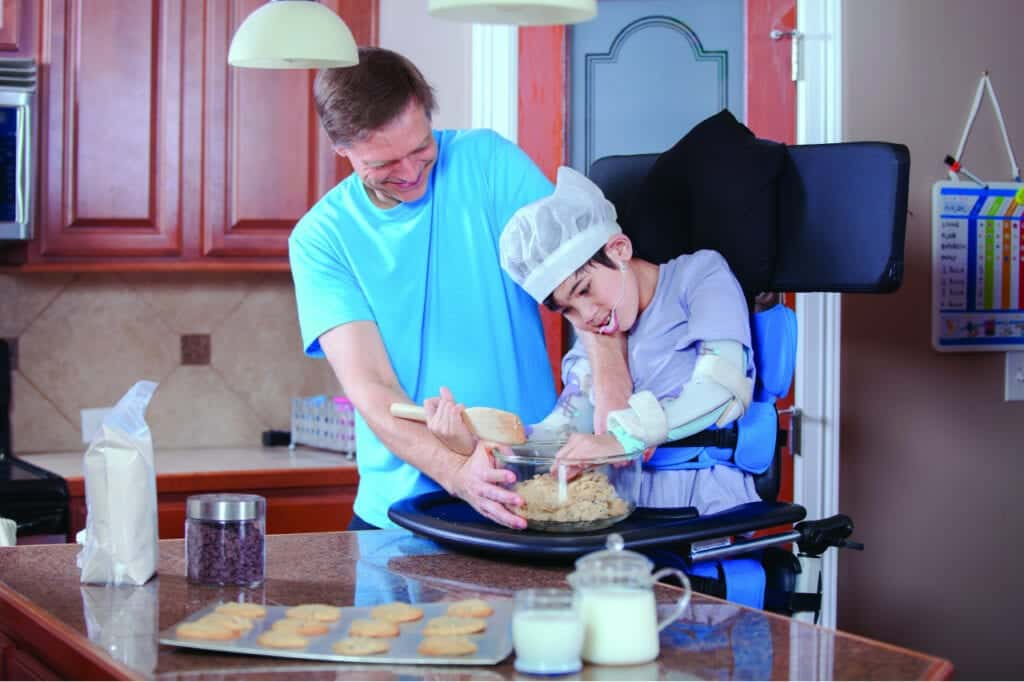
Encouragement and Standing Success
Rehabilitation therapists and other medical professionals have the opportunity to influence the way a person with a disability treats their body for the rest of their life. People who are affected by mobility impairments often credit members of the inpatient and outpatient rehabilitation staff for their persistence in standing well after the therapy ends. Therapists can help motivate patients by sharing success stories about people who initiated and have successfully maintained standing.
“There is so much that a person with a new disability can’t control,” Roy says. “Prescribing a standing program has proven physical and mental benefits, and it is an activity that a person can look forward to,” she says.
Understanding the necessity of proper patient/end user training is also important in achieving success with standing programs. Therapists can influence success of the overall standing program by understanding the tolerance of each individual along with the activities in which that individual wishes to participate, according to Roy.
At times, she says, this may require additional visits with medical personnel to work on functional activity access or improve independence with standing. On a professional level, engaging in education about the benefits of and clinical reasoning related to standing equipment is important, as well as advocating for policies that cover standing devices.
“Therapists can also make long-term changes to help their patients obtain funding for standing devices by getting involved in advocacy efforts,” Roy says. She explains that advocacy can take the form of writing letters of medical necessity to an insurance company or getting involved with organizations such as the United Spinal Association and the Christopher & Dana Reeve Foundation.
“It is our job as clinicians to educate lawmakers about the health benefits of standing and why paying for standing is cheaper than paying for the health problems that can occur when people do not stand,” Roy adds. RM

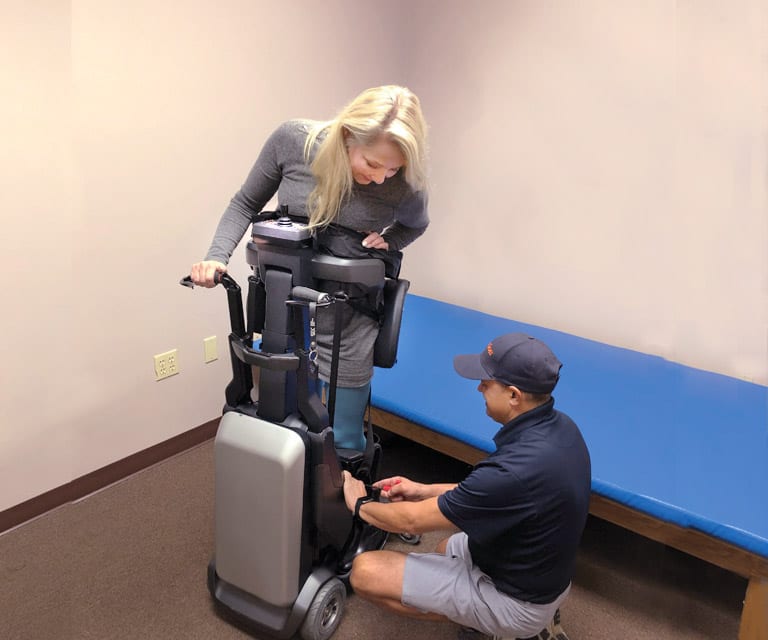


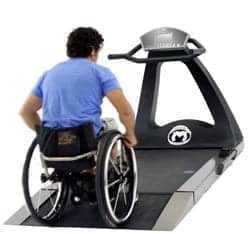
What is the brand and model of the standing device Roy is using in th3 photos?
Hi Elizabeth — I’ve asked the author to respond to your question.
Hi , that is the TEK RMD made by Matia Robotics. They are coming out with a new model with summer, but that is the original model available in the United States.